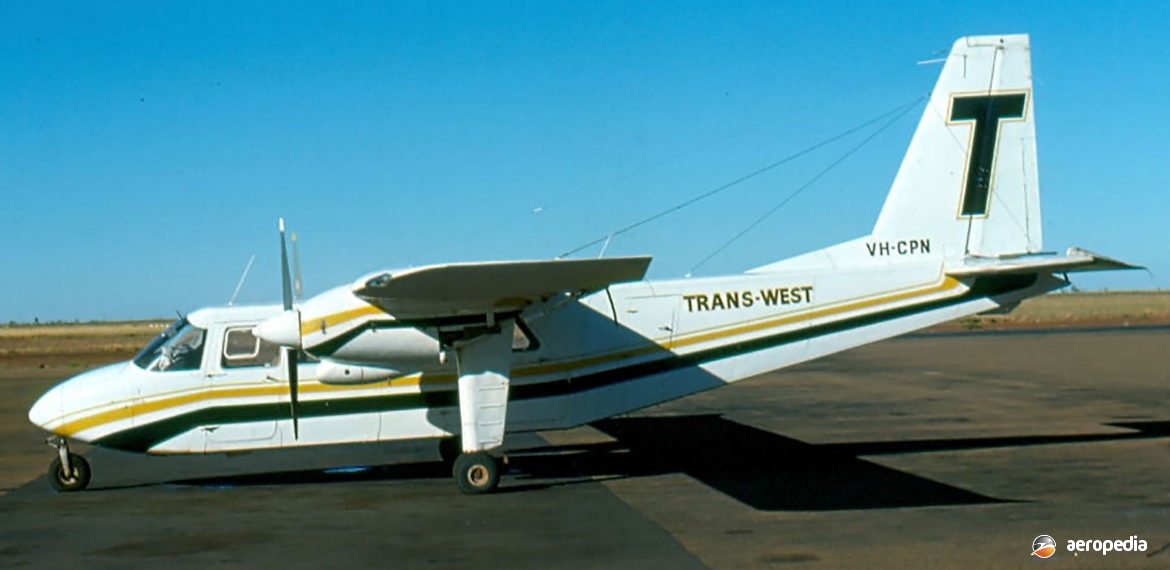Photograph:
Britten Norman Islander VH-CPN (c/n 180) of Trans-West at Port Hedland, WA in July 1977 (Roger McDonald)
Country of origin:
United Kingdom
Description:
Light twin-engine commercial transport
Power Plant:
Two 194 kw (260 hp) Avco Lycoming O-540-E4C5 six- cylinder horizontally-opposed air-cooled engines
Specifications:
- Wingspan: 14.94 m (49 ft)
- Length: 10.86 m (35 ft 7¾ in)
- Height: 4.18 m (13 ft 8¾ in)
- Wing area: 30.19 m² (325 sq ft)
- Max speed: 290 km/h (190 mph)
- Typical cruising speed at 2,750 m (9,000 ft): 270 km/h (168 mph)
- Initial rate of climb: 381 m/min (1,250 ft/min)
- Service ceiling: 5,013 m (16,400 ft)
- Range at typical cruising speed: 1,287 km (800 miles)
- Empty weight: 1,695 kg (3,738 lb)
- Loaded weight: 2,857 kg (6,300 lb)
History:
Designed in 1966 by one of Britain’s smallest aircraft manufacturing companies, the Britten Norman Islander became the best-selling British multi-engine commercial aircraft. Over 1,200 examples were built and sold in a variety of models. Early in the aircraft’s production life two engine types were available, as well as variants with the wingtips extended by 1.22 m (4 ft) and the nose extended by 1.17 m (3 ft 10 in) for extra cargo space. A variety of models to meet various military applications was proposed. A facility was built at Bembridge on the Isle of Wight to meet orders and a contract was awarded to the Westland Group, the main initial output coming from the Cowes facility of the British Hovercraft Corporation also on the Isle of Wight.
In 1972, when the Britten Norman company was taken over by the Fairey Group, production continued on the Isle of Wight, and in Romania, the first Romanian aircraft G-AXHY (c/n 85/601) being completed from English parts and being flown on 4 September 1969. In 1977, despite continuing sales, more problems were experienced and production was taken over by the Swiss Pilatus Company in 1978, the type subsequently becoming known as the Pilatus Britten-Norman Islander.
The prototype Islander G-ATCT (c/n 41) flew with 157 kw (210 hp) Rolls Royce Continental IO-360-B engines for the first time on 13 June 1965. Later that year it was re-engined with 194 kw (260 hp) Avco Lycoming E4C5 engines and first flew in this form on 17 December 1965, later being joined by the second prototype G-ATWU (c/n 42) in the certification program in August 1966.
An unusual feature of the design was the ‘wall-to-wall seating’, access to each row of seats being through a separate door, thus obviating the necessity for an aisle. After a short time 224 kw (300 hp) engines were offered as an option, the first aircraft fitted with these being flown on 30 April 1970. A variant with 201 kw (270 hp) TIO-540-H supercharged engines was developed and certificated for high altitudes. The first of this model flew on 30 April 1971.
After some years, with the trend towards turboprops because of the high price of aviation fuel, some testing was done with an Islander fitted with Lycoming turboprops. Eventually the proven Allison 250-B17C turboprop of 313 kw (420 shp) flat-rated to 239 kw (320 shp) was fitted and certified.
To denote the different models of aircraft, Britten Norman introduced a series of ‘dash numbers’. The basic aircraft was the BN-2A; the aircraft with numbers –1, -6, -7, -8, and –9 had 194 kw (260 hp) engines; the –2 and –3 models had 224 kw (300 hp) engines; and the –10 and –11 models had the supercharged engines, and so on. The odd-numbered aircraft had the long-range extended wingtip tanks and the even-numbered did not. The 224 kw (300 hp) engines permitted an increase in total weight to 2,993 kg (6,600 lb). The BN-2A-30 and –31 were amphibious versions.
Some 45 examples of the Islander have been registered in this region, and these have been used extensively by charter organisations and commuter airlines. In New Zealand a number operated by Mt Cook Airlines were fitted with skis for operations from snow.
The first aircraft of the type seen in this region were those entered in the London – Sydney Air Race in December 1969, thus combining delivery flights to the new owners, and taking part in the Air Race at the same time. Those entered included G-AXSN (c/n 81) and G-AXUD (c/n 132). The latter achieved first place in the race, and then continued on to enter service in New Guinea with Aerial Tours of Papua New Guinea, with which it was registered VH-ATZ.
A few have been used by parachute clubs. One interesting Islander registered was VH-LRX (c/n 504) which, in 1977, was converted to take two Lycoming LTP-1-1 turboprops and had an extended nose, but this scheme was discontinued and the aircraft placed in storage until it was rebuilt with piston engines, later being exported to the United States.
Towards the end of its production life production variants were known as the BN-2B-20 and –26, manufacture being carried out by IAV Bucuresti in Romania. Licence production was also undertaken by Philippine Aerospace Development. By late 2015 26 examples remained on the Australian Civil Aircraft Register.
In 2023 Torres Strait Air ordered ten Islanders as part of a five-year revitalisation program.

